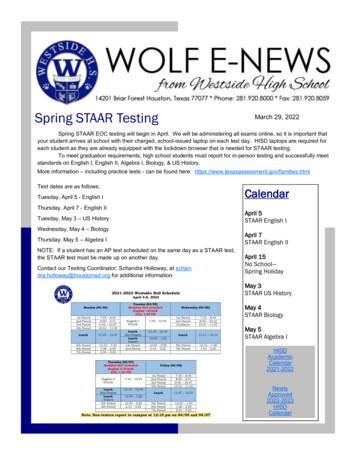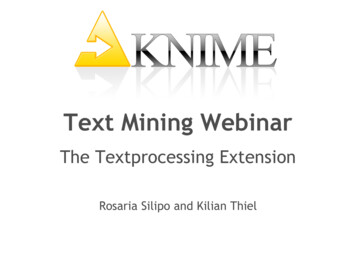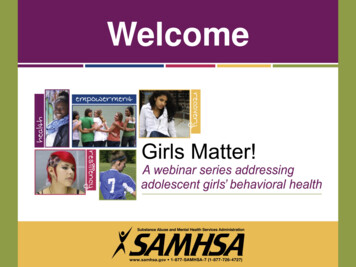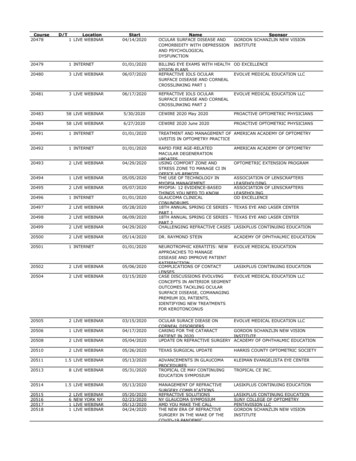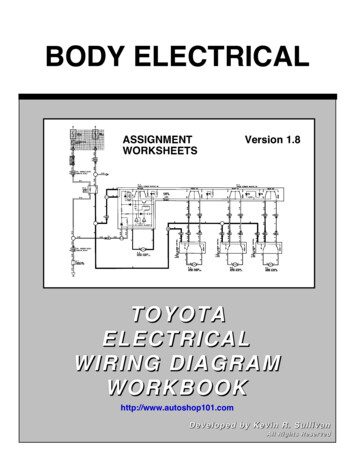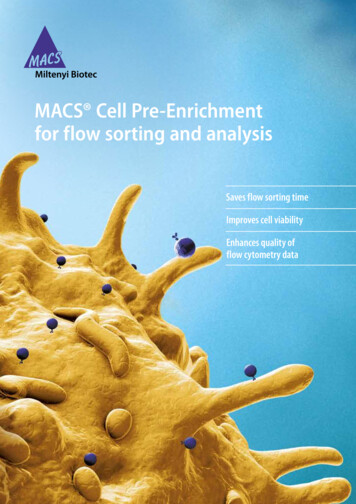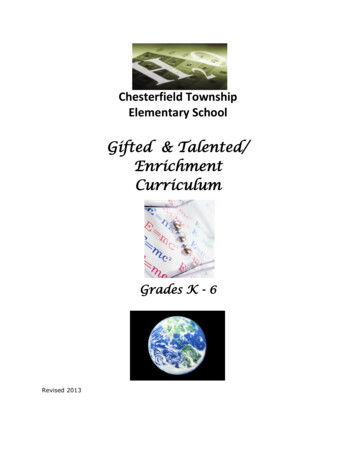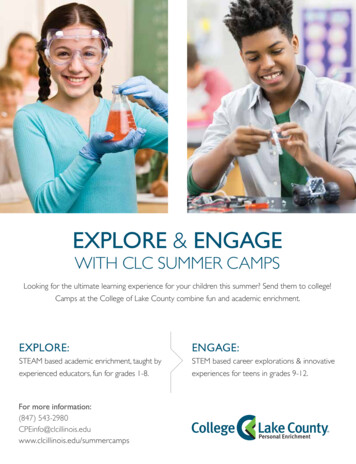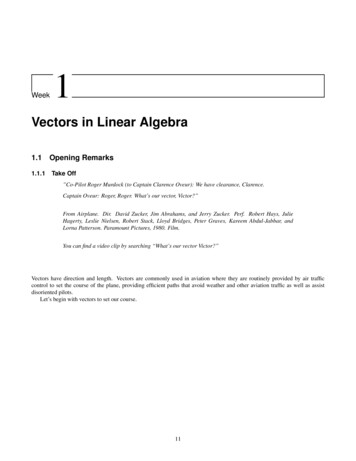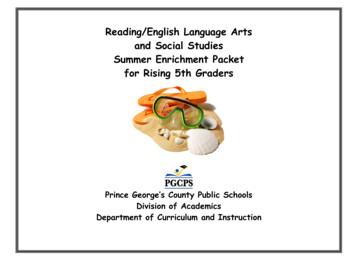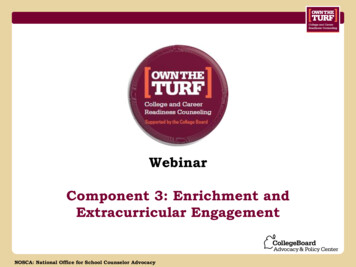
Transcription
WebinarComponent 3: Enrichment andExtracurricular EngagementNOSCA: National Office for School Counselor Advocacy
PresenterJennifer Dunn, DirectorThe College Board National Officefor School Counselor Advocacy(NOSCA)Co-presenterPat Cruz, Education DirectorYoung Audiences of MarylandNOSCA: National Office for School Counselor Advocacy
Ensure equitable exposure to a widerange of extracurricular andenrichment opportunities that buildleadership, nurture talents andinterests, and increase engagementwith school.NOSCA: National Office for School Counselor Advocacy
Defining Extracurricular andEnrichment ActivitiesExtracurricular and enrichment activities are school orcommunity sponsored programs, clubs, or activities that occuroutside of the regular course of study.1. School-sponsoredExamples: athletics, drama, art and debateclubs, STEM, service-learning etc 2. Community-sponsoredExamples: Hobby clubs and youth organizationslike summer bridge programs, arts/localcommunity theater program, museum familynight, Talent Search or Boy/Girl Scouts activitiesSource: National Center for Educational Statistics, Trends Among High School SeniorsWebsite: www.nces.ed.gov/programs/digest/d10/app b.aspNOSCA: National Office for School Counselor Advocacy
3. Work Based Learning ProgramInformal and Formal Work Experiences Use student’s work-sites and jobs to enhance schoolbased academic and technical learning Businesses, organizations, and industries connectwith schools Develop workplace habits, customer relations skills,and link academic curriculum to workplacelearningExamples: Trade/Vocational, and professionalclubs like Future Farmers, Business Leadersand Teachers of AmericaSource: National Center for Educational Statistics, Trends Among High School SeniorsWebsite: www.nces.ed.gov/programs/digest/d10/app b.aspNOSCA: National Office for School Counselor Advocacy
Today’s WebinarLearn how Component #3: Extracurricular and Enrichment activitiesprovide students the foundational and transferable skills necessary tobe college and career ready.Measure the success of your Extracurricular and Enrichment programsand find out how well you are servicing and fostering college and careeraspirations, interest, and talents of all students.Discover how Extracurricular and Enrichment activities have increasedstudents’ engagement, build aspirations and develop leadership Kthrough 12th grade (Programs in the Arts).Discover ways in which you can integrate your Extracurricular andEnrichment activities into the overall education program.NOSCA: National Office for School Counselor Advocacy
The President’s Goal is to lead the world in thenumber of college graduates by 2020—movingthe college completion rate from 40% to 60%for 25 – 34 year olds.Economic Security and a 21st Century Education: Secretary Arne Duncan’s Remarks at the U.S. Chamber ofCommerce’s Education and Workforce Summit, 200940%50%60%NOSCA: National Office for School Counselor Advocacy
US Population Projections to 2050Source: Internet Stats Today, http://internetstatstoday.comNOSCA: National Office for School Counselor Advocacy
Who is Going to College?White, non-HispanicHispanicBlack, non-HispanicSource: Education Pays 2010, College BoardNOSCA: National Office for School Counselor Advocacy
Unemployment Rate by Race/Ethnicity16%11.3%8%7.8%Source: hics/NOSCA: National Office for School Counselor Advocacy
NOSCA’s Eight Components of Collegeand Career Readiness CounselingA Systemic K-12 ApproachThe Road MapNOSCA: National Office for School Counselor Advocacy
College and Career Readiness CounselingA Systemic K-12 ApproachElementary School – To create early awareness, knowledge and skillsthat lay the foundation for academic rigor and social developmentnecessary for college and career readiness.Middle School – To create opportunities to explore and deepencollege and career knowledge and skill necessary for academicplanning and goal setting.High School – To create college and career pathways that promote fullimplementation of personal goals that ensure the widest range offuture life options.NOSCA: National Office for School Counselor Advocacy
The Skills Gained are Foundational and Transferrablewithin the Eight Components#4-Collegeand CareerExplorationand rEngagementNOSCA: National Office for School Counselor Advocacy#7-Collegeand CareerAdmissionProcesses
Percent of High School Seniors Reporting Participation in VariousExtracurricular and Enrichment Activities by GenderClass of 200417.8Academic Club24.714.816.3Vocational MaleFemale38.216.3Honor Society27.79.6Student Government15.7010Trends Among High School Seniors 1972-2004Source: National Center for Education StatisticsMay, 2008NOSCA: National Office for School Counselor Advocacy2030405060
Percentage of High School Seniors Reporting Participationin Various Extracurricular Activities by Race/EthnicityClass of 200417.715.5Academic Club11.3Vocational Club8.622.635.516.5White16.8Hispanic/LatinoAfrican 734.3Sports/Athletics39.5Student Government26.21213.1Honor Society9010Trends Among High School Seniors 1972-2004Source: National Center for Education StatisticsMay, 2008NOSCA: National Office for School Counselor Advocacy45.629.513.213.513.220304050
How Do You MEASURE Success?A ―3‖ Step ProcessGoalRelevant DataIdentifyDisparitiesNOSCA: National Office for School Counselor Advocacy
GoalEnsure equitable exposure to a widerange of extracurricular andenrichment opportunities that buildleadership, nurture talents andinterests, and increase engagementwith school.Source: High School Counselor's Guide: NOSCA’s Eight Components of College and CareerReadiness Counseling, National Office of School Counselor Advocacy, The College Board,2011.NOSCA: National Office for School Counselor Advocacy
Relevant DataWhat To MEASURE: Participation in enrichment activities Participation in extracurricular activities Students in leadership positions inenrichment and/or extracurricularprogramsSource: High School Counselor's Guide: NOSCA’s Eight Components of College and CareerReadiness Counseling, National Office of School Counselor Advocacy, The College Board,2011.NOSCA: National Office for School Counselor Advocacy
IdentifyDisparities How does participation in enrichment activities of 9th grade malescompare to that of 9th grade females? Do African American males participate in STEM programs at thesame rate as White males? How does the percentage of white students with the leadershipposition in extracurricular activities compare to that of AfricanAmerican students?Source: High School Counselor's Guide: NOSCA’s Eight Components of College and CareerReadiness Counseling, National Office of School Counselor Advocacy, The College Board,2011.NOSCA: National Office for School Counselor Advocacy
Who are the underserved or underrepresented students inyour enrichment and extracurricular activities at yourschool and/or in your district? African American Latino Native American Students from Low SES Backgrounds English Language Learners Students with Disabilities OtherNOSCA: National Office for School Counselor Advocacy
The Benefits of the Art’s in EducationNOSCA: National Office for School Counselor Advocacy
Art’s in EducationLearning a musical instrument ormastering musical notation can helpstudents succeed in mathVisual arts instruction improvesreading readinessReading, math, and writing requirestudents to understand and usesymbols –– and so does assemblingshapes and colors in a portrait orusing musical notes to learn fractionsPresident’s Committee on Arts and HumanitiesReinvesting in Arts Education Winning America’s Future Through Creative SchoolsMay, 2011College Board Arts at the CoreThe National Task Force on the Arts in Education2009NOSCA: National Office for School Counselor Advocacy
Our Expert PanelistPatricia J. CruzEducation Director Young Audiences/Arts for LearningPAT CRUZ is Education Director for the Maryland Chapter of Young Audiences/Arts forLearning. The nations’ oldest arts in education non-profit organization. Pat has a Bachelor ofScience in Art Education and a Master of Teaching with an Arts Integration Focus. Pat hasworked for the MSDE as a facilitator for the Maryland Artist/Teacher Institute (MATI) since2001 and taught for Baltimore County Schools for more than ten years. While in BaltimoreCounty, Pat worked to develop “ArtsSmart” an arts integration pilot program that helped tosignificantly increase the Maryland State Assessment test scores in two struggling Title Ischools. Pat is the co-director for the Teaching Artist Institute, a professional developmentprogram established by the Maryland State Arts Council, Arts Education in Maryland SchoolsAlliance, and Young Audiences/Arts for Learning.NOSCA: National Office for School Counselor Advocacy
www.youngaudiences.orgNOSCA: National Office for School Counselor Advocacy
Extracurricular and Enrichment ActivitiesBOOST College and Career Readiness Skills1999Increase in Maryland State-wideAssessment reading scores DOUBLES!20003rd grade state-wide assessment readingscores make the top 7 in the state ofMaryland.20025th grade makes a huge jump – 2nd in theState of Maryland!2004 After only two years of the arts program,Halstead Elementary School 3rd gradershad a 38% increase in reading scores!NOSCA: National Office for School Counselor Advocacy
Extracurricular and Enrichment ActivitiesBOOST College and Career Readiness SkillsSource: University of Minnesota’s Center for Applied Research and Education Improvement, 2008 MinneapolisPublic SchoolsNOSCA: National Office for School Counselor Advocacy
Extracurricular and Enrichment ActivitiesBOOST College and Career Readiness SkillsSource: University of Minnesota’s Center for Applied Research and Education Improvement, 2008 MinneapolisPublic SchoolsNOSCA: National Office for School Counselor Advocacy
Extracurricular and Enrichment ActivitiesBOOST College and Career Readiness SkillsVerbalMath4 years arts5345404 years5435413 years5145162 years5085171 year501515½ year or less485502Average for all SAT testtakers508520Years StudyingA MusicalInstrumentMusic Education Brain PowerSource: http://www.vh1.com/NOSCA: National Office for School Counselor Advocacy28
The Importance of Imagination & Creativityin College and CareersAn overwhelming majority of voters believe that it is important forimagination and creative skills to be taught in school, with onethird saying it is extremely important.On a scale that goes from 0 to 10, where 0 is not at all important and 10 is extremely important, how important doyou think it is for imagination and creative skills to be taught in school?*8%TotalParents6%16%6% 4%32%18%34%33%37%2%Imagination1% 12%Constituency0%10%82%20%0-4Lake Research Partners, 2008Website: http://theimaginenation.net/30%5NOSCA: National Office for School Counselor Advocacy40%50%6-760%70%8-980%90%100%10
Critical-Thinking21st Century Student Outcomesand Support SystemsCommunicationCollaborationCreativitySource: Partnership for 21st Century SkillsWebsite: www.p21.org/NOSCA: National Office for School Counselor Advocacy
Elementary, Middle & HighCollege and Career Skills/21st Century SkillsActivitiesCollaborationDramatizing a StoryCultural & Global AwarenessLearning and African BootDance (Origins of Stepping)Creativity & InnovationCreating an Artist Book that isa 3-D Self PortraitCritical ThinkingCompose a Song:School Counselors RockNOSCA: National Office for School Counselor Advocacy
Parent and Family Involvement through the Arts Increases Parent/Family Involvement Through: Student performances at school sponsored event Increased comfort level Provides an inclusive environment for all students fromdiverse backgrounds and culturesNOSCA: National Office for School Counselor Advocacy
Integrating the Arts into Your College and Career ProgramSample Activity:Career Character InterviewsA Dramatic Technique to Motivate Students to Think about CareersStep 1:Acting Tools: Voice, Body, Imagination, CooperationNOSCA: National Office for School Counselor Advocacy
Integrating the Arts into Your College and Career ProgramSample Activity:Career Character InterviewsA Dramatic Technique to Motivate Students to Think about CareersStep 1:Acting Tools: Voice, Body, Imagination, CooperationNOSCA: National Office for School Counselor Advocacy
Integrating the Arts into Your College and Career ProgramSample Activity:Career Character InterviewsA Dramatic Technique to Motivate Students to Think about CareersStep 2:Select a Character/Career- Painter- InventorNOSCA: National Office for School Counselor Advocacy
Integrating the Arts into Your College and Career ProgramSample Activity:Career Character InterviewsA Dramatic Technique to Motivate Students to Think about CareersStep 3:Model the use of the acting tools to impersonate your characterwith the classNOSCA: National Office for School Counselor Advocacy
Integrating the Arts into Your College and Career ProgramContinuing the Sample Activity Step 4:Break into groups – assign each group a career toimpersonateCRITERIA: you must use all 4 acting tools, and must usefacts/information appropriate to your career when answeringinterview questionsNOSCA: National Office for School Counselor Advocacy
Integrating the Arts into Your College and Career ProgramContinuing the Sample Activity Step 5:Groups perform and score each other’s work based on criteriaNOSCA: National Office for School Counselor Advocacy
Integrating the Arts into Your College and Career ProgramContinuing the Sample Activity Step 6:Reflection Questions/Discussion – refer back to CriteriaCRITERIA:-use all 4 actingtools- use facts andinformationappropriate toyour career whenansweringinterviewquestionsAdapted from: Lenore Blank Kelner-Interactive Story TheaterWebsite: http://lbkcompany.com/aboutus-overview.htmNOSCA: National Office for School Counselor Advocacy
Four Overarching GoalsTo Integrating Enrichment and Extracurricular into the Education Program1234 Build on student’s talents, interests and skills Assist students with making informed Career and College choices Support students with developing an educational plan that leadsto career pathways Develop students skills to secure, maintain, and advance in achosen a careerNOSCA: National Office for School Counselor Advocacy
Arts Education ResourcesMaking Books: Learn to make simple handmade books with recycledmaterials.Website: www.makingbooks.com/kids/The Walters: Art integrated lessons and activities for your students.Website: www.thewalters.orgKennedy Center: This site allows you to search for integrated lessonsand activities by subject, grade level and arts.Website: www.artsedge.kennedy-center.orgPresident’s Committee on Arts and Humanities: Reinvesting in ArtsEducation: Winning America’s Future Through Creative SchoolsWebsite: http://www.pcah.govNOSCA: National Office for School Counselor Advocacy
Advocacy CampaignNOSCA: National Office for School Counselor Advocacy
Be Part of a National Movement!Gain Strategies and Tools:The Eight Components, Advocacy KitBuild a National Community of School Counselors:Online Community, Workshops, BlogShare College and Career Readiness Counseling Programs and Practices:Examples of Eight Components ImplementationSupport the Pathways for College Act:Learn More at advocacy.collegeboard.org/get-involvedElevate Counselors’ Voices:College Board’s National Survey of CounselorsCampaign BenefitsNOSCA: National Office for School Counselor Advocacy
Own the Turf Campaign Toolkit16‖ x 24‖ PosterNOSCA: National Office for School Counselor Advocacy
Website: nosca.collegeboard.org/tools-resources/NOSCA: National Office for School Counselor Advocacy45
Sign up for the next NOSCA WebinarThe next Webinar will be held January 19, 2012, 1:00PMEST will be on College and Career Admission Processes(Component 7).As collaborative partners, it is imperative that schoolcounselors work to ensure that students and families,especially those from traditionally underserved populations,have an early and ongoing understanding of the college andcareer admission processes.Presenter(s):April Bell, Associate Director, NOSCA; Joyce Brown,Independent Consultant; Barbara Gill, Assistant VicePresident of Undergraduate Admissions and EnrollmentServices, University of MarylandNOSCA: National Office for School Counselor Advocacy
Questions?For further information:Visit: nosca.collegeboard.org orEmail: guidance@collegeboard.orgNOSCA: National Office for School Counselor Advocacy
Submitting Online QuestionsQuestions may be submitted at any time during thepresentation. To submit a question:Click on the Question Mark icon (?)on the floating toolbar on your WebSession screen (as shown at the right). This will open the Q&A window on yourcomputer only. Type your question into the smalldialog box and click the Send Button. NOSCA: National Office for School Counselor AdvocacyQ&A icon
NOSCA: National Office for School Counselor Advocacy Today's Webinar Learn how Component #3: Extracurricular and Enrichment activities provide students the foundational and transferable skills necessary to be college and career ready. Measure the success of your Extracurricular and Enrichment programs and find out how well you are servicing and fostering college and career
